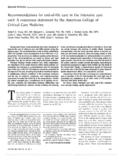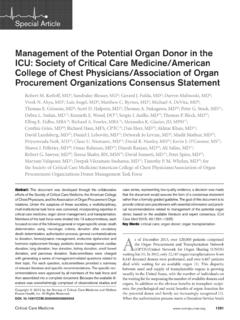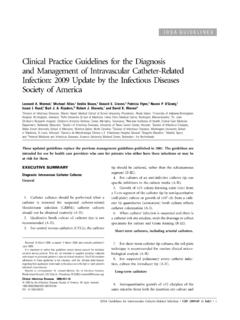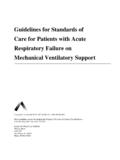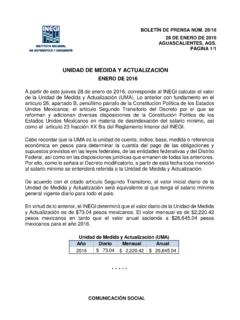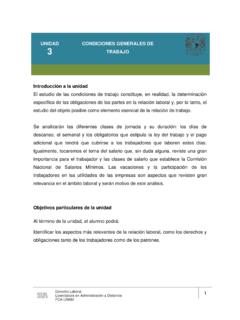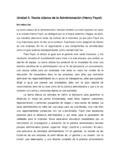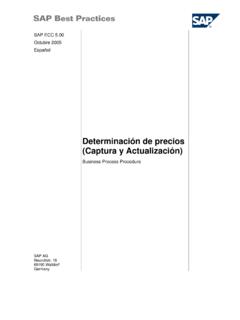Transcription of Guidelines on Admission and Discharge - LearnICU.org
1 Guidelines on Admission and Discharge for Adult Intermediate Care Units Copyright by the SOCIETY OF CRITICAL CARE MEDICINE These Guidelines can also be found in the March 1998 issue of Critical Care Medicine -- Crit Care Med 1998 Mar; 26(3):607-610 Society of Critical Care Medicine 701 Lee Street Suite 200 Des Plaines, IL 60016 Phone: 847/827-6869 Society of Critical Care Medicine_____ 2 Guidelines on Admission and Discharge for Adult Intermediate Care Units American College of Critical Care Medicine of the Society of Critical Care Medicine INTRODUCTION In acute care hospitals, one can identify a patient population that does not require intensive care but needs more care than that provided on a general ward. These patients may require frequent monitoring of vital signs and/or nursing interventions, but usually do not require invasive monitoring.
2 In a study of 706 surgical and medical ICU patients, this patient population accounted for approximately 22% of all ICU bed days (1). In a more recent study of 17,440 ICU admissions, 6,180 patients were admitted strictly for intensive monitoring, though they had a less than 10% risk for requiring active treatment based on this monitoring (2). As a consequence, intermediate care has been proposed as a more appropriate means of resource utilization for these patients (2-6). Intermediate care areas can be represented as multipurpose "progressive care units" or as single-organ subspecialty floors such as cardiac telemetry, surgical (thoracic, vascular, etc.), neurosurgical/neurological monitoring areas, or chronic ventilator respiratory care units (7-11). In light of the recent emphasis on cost containment, the intermediate care unit concept is suggested as a strategy that promotes greater flexibility in patient triage, increases accessibility to limited intensive care and provides a cost-effective alternative to critical care unit Admission , particularly for patients with a low risk of, but potential for, major complications and who have been admitted for routine monitoring (7, 11-16).
3 Moreover, patient satisfaction may be increased since an intermediate care environment is less noisy and may have more liberal family visitation policies (17). There are few reports demonstrating the efficacy of intermediate care as a graded option between conventional ward care and intensive care. Most studies are retrospective or uncontrolled observational series (13). There is only one randomized, controlled study demonstrating reduced costs without a negative impact on outcome (16). Franklin and colleagues observed a decrease in the case fatality rate of a large urban medical service after the introduction of an intermediate care unit, noting an important reduction in the number of "low risk monitoring" admissions to their intensive care unit; this unit effectively increased the ready availability of critical care services to those patients most urgently in need, streamlining the ICU Admission process, and attenuating unnecessary ICU stays or delays in transfer (7).
4 In addition, these changes were associated with fewer ward cardiac arrests, presumably because of more timely and appropriate levels of observation. Byrick et al. compared the initial impact on ICU utilization of opening an intermediate care unit, followed by closure of that unit (6,12). The intermediate care unit led to earlier extubation and Discharge from the ICU, and shortened overall length of stay with no change in outcome. The availability of intermediate care increased ICU bed availability and freed the operating room schedule from being ICU-dependent. Nine years after opening, the intermediate care unit was dismantled due to hospital budgetary constraints. This closure led to a four-fold increase in ICU admissions with a lower severity of illness. The lack of stepdown resources caused a reduction in triage flexibility, which negatively impacted on ICU Discharge planning and required longer ICU stays for "sicker" patients.
5 Based on this comparison, intermediate care was reinstituted (12). Intermediate care reduces hospital costs by decreasing staffing to coincide with the need of the patients (2,3). Since personnel costs may comprise up to 80% of total ICU expenses, the savings afforded by a reduction in staffing necessary for patients with intermediate severities of illness can be substantial (14-18). These savings may be overstated if the reduction in nursing staff is partially offset by the need for additional healthcare team members ( , respiratory therapy). Similarly, there may not be a large difference in supplies and capital expenditures if the reduced use of invasive monitoring is counterbalanced by implementation of any of an increasing array of noninvasive monitoring equipment (3).
6 However, there may be real and substantial savings from the change in protocol practice that occurs with transfer out of an ICU. Douglas et al. (16) established a stepdown facility for the Society of Critical Care Medicine_____ 3"chronically critically ill" (ICU length of stay >7 days, hemodynamically stable). This study is the only prospective, randomized trial to triage patients to an intermediate care unit who qualified based on pre-established criteria (16). The role of house officers was eliminated and the number of routine diagnostic laboratory tests and radiographs was sharply reduced. This change in protocol practice translated into "hidden" but substantial savings (16). The investigation by Franklin et al. found a decrease in mortality with intermediate care, but further research is needed in this area (7).
7 Sophisticated designs for the study of intermediate care should include concurrent, randomized controls rather than using sequential prospective study periods. Little attempt has been made to quantify the impact of intermediate care on reducing ICU readmissions ("bouncebacks"), , patients who are discharged from the ICU and require urgent return within 48 to 72 hours (19, 20). The costs of different levels of care must also be studied, with methods that control for diagnosis, comorbidities and severity of illness (13). These kinds of studies are needed before the benefits and limitations of intermediate care can be fully appreciated. Research that evaluates these Guidelines will promote their standardization and improvement, and this may improve patient outcome. RECOMMENDATIONS The American College of Critical Care Medicine developed by consensus the following recommendations to promote safe triage of patients to intermediate care units.
8 Rating System Level 1: Convincingly justifiable on scientific evidence alone. Level 2: Reasonably justifiable by available scientific evidence and strongly supported by expert critical care opinion. Level 3: Adequate scientific evidence is lacking but widely supported by available data and expert critical care opinion. 1. (Level 2) The intermediate care unit serves as a place for the monitoring and care of patients with moderate or potentially severe physiologic instability, requiring technical support but not necessarily artificial life support. The Intermediate Care Unit is reserved for those patients requiring less care than standard intensive care but more than that which is available from ward care.
9 2. (Level 1) The intermediate care unit reduces costs, reduces ICU length of stay without increasing hospital length of stay, does not impact negatively on patient outcome and improves patient/family satisfaction* by providing a physical environment that is quieter and calmer than the ICU. 3. (Level 3) The intermediate care unit should have designated Physician and Nurse Directors who can be responsible for assuring appropriate patient triage through enforcement of the Admission and Discharge criteria. This triage must involve personnel from the general wards, the ICU, the post-anesthesia care unit ( , recovery room), and others so that a system is developed which meets the needs of the patient and the institution efficiently and economically. *Shown for pediatric but not adult ICUs Society of Critical Care Medicine_____ 44.
10 (Level 3) The Physician and Nurse Directors should determine the limits of care that can be rendered in the intermediate care unit, based on institutional needs, staff qualifications and unit resources. This assessment includes the extent of invasive monitoring, telemetry, mechanical ventilation and types of intravenous medications. 5. (Level 3) Each intermediate care unit should develop specific Admission and Discharge policies and procedures, patient care standards, and outcome criteria for quality assessment (continuous quality improvement). Tools should be developed to monitor outcomes and other performance measures. Compliance with Admission and Discharge policies should be monitored and deviations reported to the hospital quality improvement section for action.





